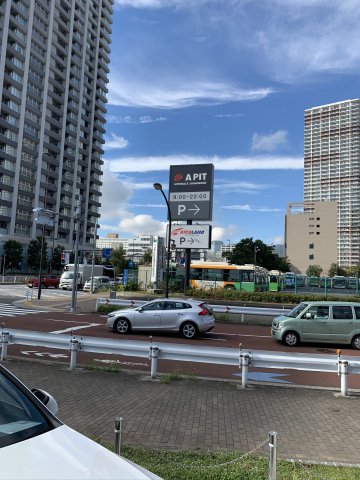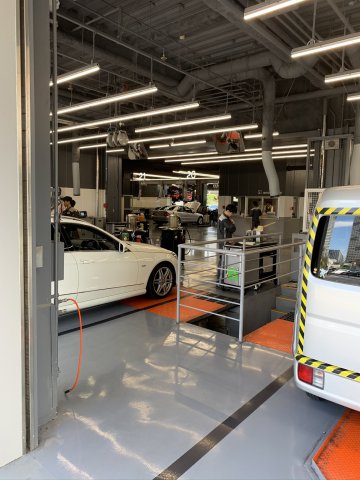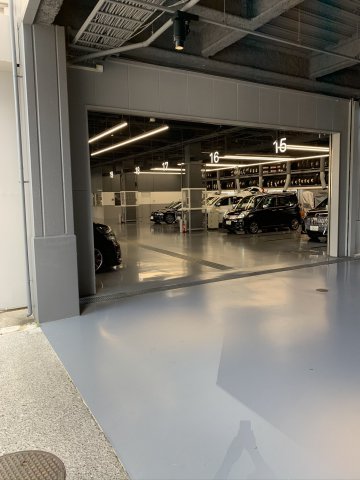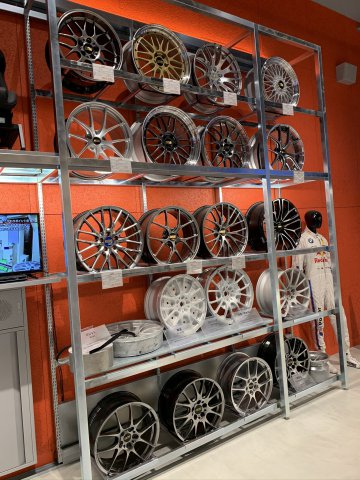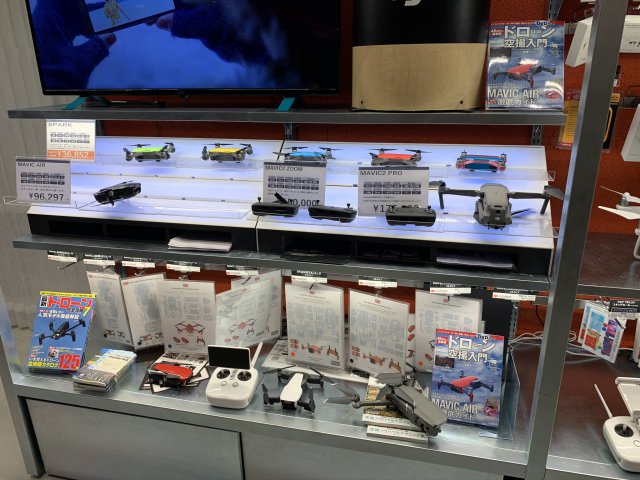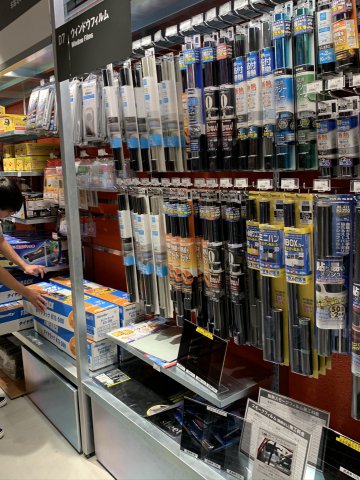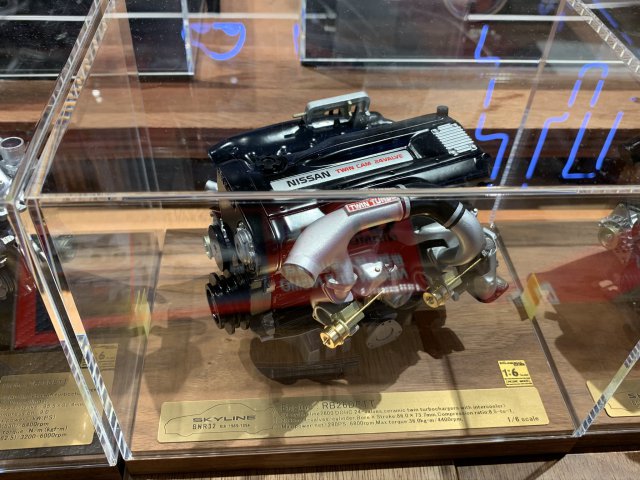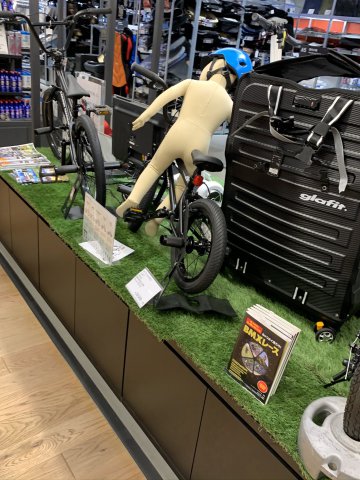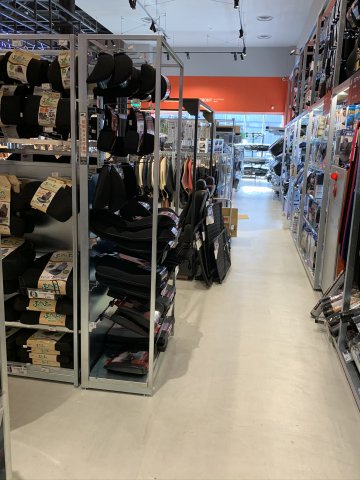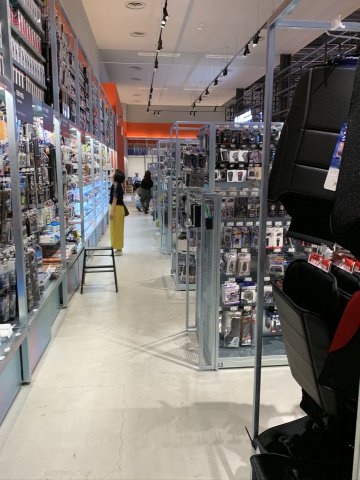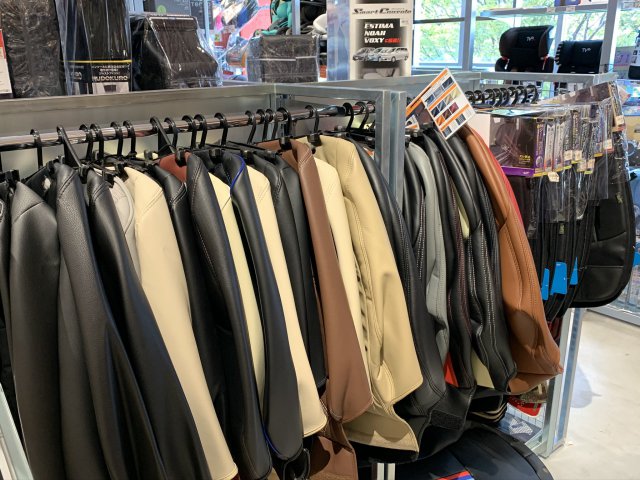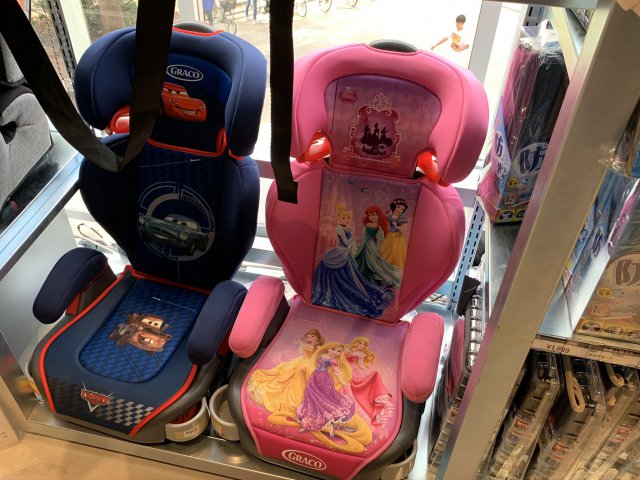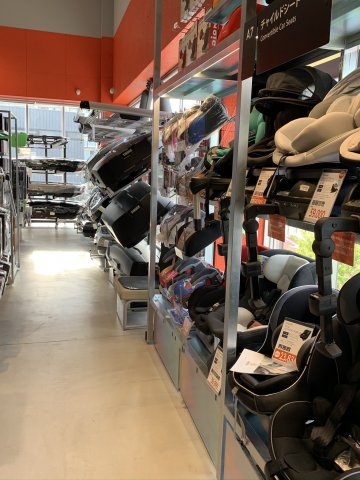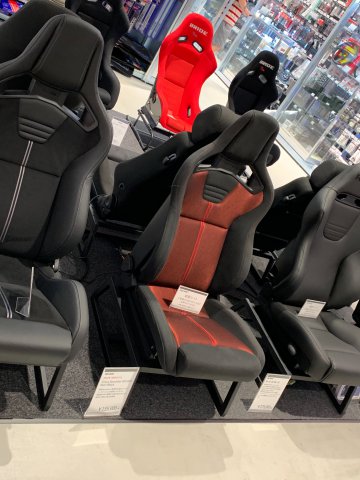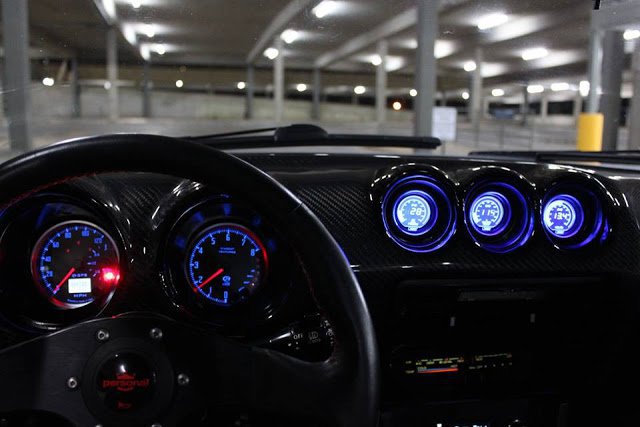
toolman
Members-
Posts
518 -
Joined
-
Last visited
-
Days Won
7
Content Type
Profiles
Forums
Blogs
Events
Gallery
Downloads
Store
Everything posted by toolman
-
Heavy Duty frame rails and connectors
toolman replied to toolman's topic in Gen III & IV Chevy V8Z Tech Board
Just returned from the Sema Show 2019. The Sema Show gets bigger and bigger every year. This 240z took part in the Optima Ultimate Street Car event. It had a Webber carbs and slightly modified suspension. Early Datsun Roadster with a Honda twin cam motor conversion with fender flares. Four passenger dune buggy A 240Z racer with carbon fiber body parts. Powered with a Chevy LS motor. With this kit, you can pull dents without grinding your paint -Glue Dent Repair Kit for $600. Water jet Cutting Machine-Note the cutout samples on the table. The very popular John Force 300mph Funny Car I had Lunch at one of the many Sema Food Trucks. the long line of customers Spicy Ribeye steak with rice for $12. Ymmmm! 1970 replica of Pete Brock's Datsun 510 The spec sheet of the 510. Harbor Freight introduced their new tool line. Their lifetime ICON tool box costs $10,000 but remember Harbor Freight usually has 20% discount coupons at their stores. The box was very well made and about half the price of a Snap On similar one. Also had ratchets,sockets, wrenches,etc. Their line of tool carts. Their MIG and TIG welders were low priced too. Their Full Function Scanner with Blue Tooth was only $999 perfect of the Do It Yourselfer. Floor jacks and jack stands Beautiful Old Datsun Roaster With a late model Nissan Twin Cam motor. Mobile Spray Paint Booth Had fresh air intake and exhaust filter system for $20,000 for average size booth, A neat Rat Rod '59 Chevy El Camino with supercharged motor Super Low!! Chopped and Shortened This booth has all sorts of Illuminated Car Signs. Toyota Nascar race car 2020 Toyota Supra 370Z with carbon fiber parts NISSAN NISMO Skyline All Wheel Drive Front view Full Functional Race Car Simulator at Supra booth Beautiful Honda Z50 Mini Bike Another Honda 50cc Monkey bike A Wild 65 Ford Van with supercharged motor. Supercharged motor with long headers Old Honda S80 with flares JooTool is a specialized small polisher for restoring small car parts. Also, sharpens knives. 3M provides various grinding, sanding and polishing discs for this machine. Outside the halls, more booths and cars This van had Four Wheel Track drive so it could go almost everywhere. Robot sanding machine made by PRO SPOT. Even had vacuum system to catch the bondo dust. Plastic welding machine with Nitrogen gas to create strong plastic welds plastic welding made by urethane Supply. more cars & people Ford Mustang one wild ride with tire burning etc. More trucks Monster trucks,too Its motor and suspension huge too. Hurst Hemi under Glass Barracuda was there too. Skelton car its supercharged motor High and Might truck 4 x 4 James Dean Replica Porsche covertible Hoogan Pit area and Burn Yard Hoogan put on a Wild Tire Burnout Show but I missed it as I thought it was over. When I was on the top of the Monorail Platform, the Burn Out Show happened. But if you want to see the Show go to: https://www.youtube.com/watch?v=NAzAI8pxyLs Hoogan guys did a preshow walk through and did crazy Burnouts and Drifting there!!!! Now, Back to working on my 240Z -
Heavy Duty frame rails and connectors
toolman replied to toolman's topic in Gen III & IV Chevy V8Z Tech Board
Back home to get working on the Z. From Epoxy Primer to Body Filler. Body Filler used to cover minor imperfections. Sanding Body Filler Then paining Polyurethane Primer Sealer on top of that bodywork. Not to forget the inside of the front fenders, the sealing of them was next thing to do. The wheel well deflector plate stripped and painted. I decided to use rubber weather stripping. I found 3M "D" shaped weather stripping on Ebay for $13 for 8 feet. The hollow inside made very soft and a good weather stripping for the wheel well. front view back view Previously I had planned to use Dynamat or similar foil type of insulation for the floor and roof. However, I decided to use Lizard Skin Ceramic Insulation paint. It can lower the interior temperature 20 to 30 degrees. One gallon costs $100 on Amazon. They also sell sound insulation paint(costs $100 gal) but it must be applied first(before heat insulation). Had planned to spray it on with a Schulz under coating gun but the coating was too thick for the gun. So I used rollers and a brush to apply it. A cordless drill was utilized to stir the paint. Use low speed and in Reverse so the particles are not damaged while mixing. Application was done in two .020 coats allowing the first coat to dry to the touch. Curing will take possible a week to completely cure depending on weather conditions. All holes must be masked off to prevent over spray. Areas to be painted are scuff sanded and all threaded holes are plugged. After painting Ceramic Coating was not difficult to apply. Cleanup should be done quickly as the insulation dries relatively fast. Pic of roof coated Pic of seat area Passenger side compartment After the Ceramic Insulation is cured, I will probably top coat it with Polyurethane White Single Stage Paint for added protection. -
Heavy Duty frame rails and connectors
toolman replied to toolman's topic in Gen III & IV Chevy V8Z Tech Board
I just got back from Tokyo. I managed to go Japan's Largest Automotive Store in Japan Autobacs Shinome located near Tokyo Bay. The garage is on the bottom of this three level store. The main store is on the Second floor and has a coffee shop there. the third floor is the high performance stuff. Snap On tools on display in glass cases. Snap On Tools tools sell for twice the US price. That Snap On tiny tool box toy sells for $140!! Snap Tools on display. On the third floor, the high performance parts and accessories were on display. They had the latest GPS., stereo ,DVD, and LED lights. And, of coarse, the garage downstairs could install whatever you purchase. Helmets, gloves and gear. the Black one cost about $5600 USD Steering wheels (Momo one was $300 USD. Racing suspension parts-NHW strut was $1350 USD There was a rear driving simulator that anyone could try for a price. It had loud speakers 3 TV screens and air shocks to give the real.feeling of a race car. I think the price was $50 for 30 minutes. Unfortunately, I found about the simulator too later as I had to get back to Shinjuku before the afternoon rush on the trains. Passengers are really packed like sardines during rush hour!!!!! The store is located near Odiba theme park by Tokyo Bay near Tokyo Disneyland. Front Entrance of the store The Garage Area is Super Clean and well lite. Mechanics even wear white gloves when working. Only High End Wheels no China Stuff here. !/6 scale Skyline motor very detailed. Bicycle and accessories Aisles of assorted stuff There is a large area with only automotive books and magazines next to their coffee shop. Everthing automotive under the Sun is here. Leather jackets Kids $500 electric cars. Kids seats more seats and seat covers $1000 Mavics RC Drones This Skyline motor sells for $300 but is well detailed. wiper blades Pet accessories Snap On floor jacks-the silver one sells for$200(about $100 in US) Can't wait to start back to working on my Z. SEMA SHOW 2019 is less than a month away. Viva Las Vegas!! -
Heavy Duty frame rails and connectors
toolman replied to toolman's topic in Gen III & IV Chevy V8Z Tech Board
The door hinges for both Left and Right sides were top coated with Polyurethane paint. Shop Tip- Removing and Installing a 240Z hood by yourself Place a Plywood on top of the Left and Right fenders. Put hood in the closed position. Put card board or padded mat under plywood to prevent scratching the paint. Raise hood to open position. Loosen all four hood bolts but do not remove. Remove both hood front bolts. Now tilt the rear of the hood downward till the hood contacts the plywood. Then remove the rear hood bolts as the hinge and plywood will support the weight of the hood. The hood can be lifted off from either side of the car. Hood installation will be the reverse procedure. The next thing to do to spraying Raptor Liner in the fender and wheel wells. This Raptor liner was the 2 bottle kit with Liner, hardener and color toner.. This kit costs about $100 including freight on Ebay. Masking the hood to prevent overspray going all over the place. The interior sides of the hood and fenders were sanded with 150 grit sand paper then wipe down with paint prep solution. view of Left side Wheel Well Housing afterspraying. Right side Wheel Well Housing after spraying Liner Right side fender interior view Inside Right Door view Closeup view of the Raptor Liner on Wheel Hosing Inside Right Fender Note- Liner even covers patch area. Left side Wheel Well Housing The Raptor Liner can be applied by hand roller or sprayed. A Schutz gun is most commonly used to apply the liner. HLVP spray gun with 2.0 nozzle can be used if liner is reduced by 20%. This method would provide a smoother finish( not as rough}. After one hour, the liner is dry to touch. It, however. takes a full week to completely cure. I used only one bottle of Raptor Liner so far. The remaining bottle will be used for the rear wheel housing after I finish flare modifications. -
Heavy Duty frame rails and connectors
toolman replied to toolman's topic in Gen III & IV Chevy V8Z Tech Board
PROJECT TIP: I am posting this tip as it may be very helpful to a lot of people. RESCUE BIT is a high speed cutting bit that will cut through broken taps, extractors just about anything. Check the video out at https://www.youtube.com/watch?v=FkIH7DhQJzA In my case, I was tapping out the bolt holes of my struts. Of course, while tapping the last bolt hole, the 6mm x 1.0 tap broke. Pic of the Broken tap This is a picture of a 1/8" RESCUE BIT with cutting edge on both sides. The 1/8" version must be used with a 1/8" adaptor to use it in a 1/4" die grinder. Pic of 1/8 to 1/4" adaptor. Rescue Bits also use to have 1/4" burrs (single and double cut version) too. Now the Rescue Bits can be found on Amazon and Ebay but only here and there. I don 't think the company still exists. I do keep one around for emergencies like this one. After drilling a hole in the center of the tap. I use a small sharp punch to collapse the walls of the tap inward. Here is one the larger pieces of the tap that was removed from the hole. After removing all remains of the tap, I carefully tapped the hole with a new 6 x 1.0mm tap. Success-bolt was threaded in!! It is important to carefully follow the instructions that come with the Rescue Bit. Also. the die grinder must be capable of 25,000 RPM. High speed and the bit design is what allows the Rescue Bit to do what other bits can not do. I hope some of you find this tip helpful. Rescue Bits costs about $60 online. -
Heavy Duty frame rails and connectors
toolman replied to toolman's topic in Gen III & IV Chevy V8Z Tech Board
When the Postman brought a large box for me, I ripped it open immediately-it was my CRX Racing Coil Over Suspension kit. Shorter ones were for the Front and Longer ones for the Rear. The cost was $850 plus $150 for freight. CRX has installation instructions at their online site. Installation is simple. You cut about 2" to 2 1/4" from the bottom of the strut tube then weld the external sleeve to the strut base. Bottom sleeve and coil over strut section. I measured the length of the coil spring to record the spring preload. The lower threaded section allows you set the ride height that you want. Strut disassembly Struts were disassembled and sandblasted to prep for welding. After taping the cutting line, I started the cut by using a hack saw. Then a SAWALL was used to finish the strut sectioning. Sectioning completed The Front Spindles had a casting bump between the tube and spindle casting. I sawed a V cut in it to provide more welding space. The Rear Spindles don't have any casting lump. Welded up spindle All four struts were sent out for powder coating as it is too bulky for my small oven to heat up. All four Spindle Backing Plates needed cleanup to be powder coated. Front Backing Plates after Powder Coating Rear backing plates powder coated Hopefully, the Powder Coating guys won't take too long on the struts so I can put the suspension back together. Trying to decide whether to use Bedlinder(Raptor, etc). Anybody have any comments about Bedliners? -
Heavy Duty frame rails and connectors
toolman replied to toolman's topic in Gen III & IV Chevy V8Z Tech Board
Next thing to work on was the rear control arms. First, I cleaned them up to remove any dirt and grease. Then, they could be sandblasted with #80 grit media. Next, removing their inner bushings was next. Using a air saw, I cut two parallel cuts in the inner metal bushing. If you don't have a air saw, you can use a hack saw. But you have to take the blade off the saw then stick in the bushing then reassemble the saw. Saw two parallel cuts through the inner metal bushing. Remove it and use a air chisel to push the inner bushing out. Try to get the bushing to collapse and fold over. If not, use a torch to burn away the rubber portion of the bushing. Besides the burning rubber, avoid being burned by hot rubber pieces. Remove all the rubber from the bushing with a wire brush. itself Now, use a Sawzall to cut two parallel cuts in the outer part of the bushing. Be careful not to damage the control arm while doing this task. Use a air chisel to collapse and push the bushing out of the arm. The removed outer bushing should resemble something like this. If the control arm was damaged while removing the bushings, you can repair it before installing the new bushings. The control arms ready for powder coating. . Control arm in my powder coating oven. Now, I have to wait till my control arm bushings to arrive so I can press them in. -
Heavy Duty frame rails and connectors
toolman replied to toolman's topic in Gen III & IV Chevy V8Z Tech Board
The wheel fitment tool was designed to go to even a 12" wide tire. As I only had a 8" wide tire, one has to imagine the other 4" extending inside the fender. First, Zeroing the Camber gauge Camber gauge zeroed in. Then, holding the straight edge with camber gauge against the outside of the tire. The Camber reading is 1 1/4 degrees Pos This wheel/tire combination would require a 3" fender flare. In this case, the wheel had a 2" Negative offset-the wheel center was 2" inward of center of the wheel. The 245 X 18 X 8 offset wheel/tire combination looks like this from the front view. A mild street look. . Do not forget that the ride height is still not correct. The present ride height is about 3" to 4" higher than what it will be with the new coil over suspension. Lowering the vehicle will create negative camber and bring the camber to closer to a zero reading. Also, keep in mind, these are only simulations and I am going to larger tires and wheels. -
Heavy Duty frame rails and connectors
toolman replied to toolman's topic in Gen III & IV Chevy V8Z Tech Board
Back in 1971, this 71 240Z was my First and Only Car. It was a Total Wreck- the owner ran it into a large Bulldozer parked on the side of the road. My father owned a automotive body shop which had 5 frame machines. We fixed often repaired totaled cars. So we put it on the frame machine and pulled it straight with multiple 10 ton hydraulic rams. Then the damaged pieces were replaced with OEM parts. I drove the car "stock" for about a year but decided it needed more power. I first checked into modifying the Nissan 6 cylinder motor by Weber carbs, turbocharging and 5 speed racing transmission). But those options were way too expensive. Being a Chevy drag racer, putting a Chevy 327 motor with Turbo 400 transmission seemed like a easy answer. So after gathering all of the needed parts, I pulled the old six engine out and put the 327 in. I had the car running in a week time because I had to use vacation time to do the conversion. At a later date, I put a more powerful 350 and T-5 five speed trans and put metal flares on. In 1988, I bought my second car 88 Chevrolet Astro Van for business. My 240z was basically sitting in the garage since that time. So I owe it to spent some time restoring it as the best that I can do. I hope this story explains my restoration. Back to the restoration: I put the Wheel Fitment Tool on the car to check the wheel alignment out. But first, had to remove the strut coil spring as it won't allow the body to drop as there was no engine weight and accessories. Took out spring Put the Wheel Fitment Tool to test it out. Wooden blocks were placed under the lower control arm to adjust ride height. The car is still on a dolly which lifts the vehicle about 1" higher than a stock Z. Using a Tool Aid Wheel Alignment gauge to check Camber readings. A carpenters square shoed the hub to be close to zero so I set the gauge to zero degrees, After checking the Square with the ground, I reversed it to better demonstrate camber. By tilting the straight edge top outward(away from the car) to stimulate Positive Camber. Positive Camber To stimulate Negative Camber, I titled the top of the straight edge inward( toward the engine compartment). Negative Camber I think there was a misunderstanding about what I trying to accomplish. In my particular case, I am trying to eliminate as much Negative Camber that I can. Lowering the car with shorter springs, lower ride height, extra wide wheels,etc will create a lot of Negative Camber. Shortening the lower control arms, upper camber plates, modified spindles,etc maybe utilized to provide Positive Camber to achieve alignment. My car will be basically a Street Car and not a Race Car requiring 3 degrees Negative Camber. Now, you can even change front and rear crossmembers to get the alignment that you want. -
To me, Apex Engineering did an excellent job on both front and rear suspension upgrades. Considering the upgrades are basically a bolt on kits, a lot of thought went in its design. The only problem that I can see is having the rear coil overs operating in the hatch area. In a race car, the noise and danger from moving parts in the passenger compartment would not be a problem. In a street car, those problems would arise. However, maybe they thought of it and have conventional struts that would work instead. Awesome design. I would consider using the rear upgrade as I will have a Rocket Bunny Body Kit.
-
Heavy Duty frame rails and connectors
toolman replied to toolman's topic in Gen III & IV Chevy V8Z Tech Board
Threaded inserts-5MM -.8 were used to fastening the roof of the cowl vent. This will allow easy removal at a later date. 5MM-.8 stainless steel screws hold on the roof section. Finished cowl vent. The battery tray was finished using seven 8mm-125 stainless steel bolts and threaded inserts to hold it down. The four 1" holes in the frame rails were plugged by 1 1/4" white plastic plugs found on Ebay. A 1" clear plastic hose was inserted into the plug. This forced the plastic arms to expand outward and provided a tight fit. After installing the engine crossmember, I needed to replace the camber eccentric in them. Old ones were worn out. 69-70 Dodge Darts had similar ones. This is NAPA version of eccentric camber adjusters for only $25 for two. Locking nut side Camber Adjusting nut side This kit gives about Plus or Minus One degree Camber adjustment. Installation only requires slotting the bolt hole and a little welding. Next Topic is the Hood Hinge torsion spring installation. First, install in either hinge, all the three mounting bolts. On the other side hinge, loosely install only the mounting bolt on the hinge nearest firewall. Plastic tie was used to hold the first rod(one on the left] in stationary position and also hold the second rod with hat in the swivel bracket. The plastic tie in the rods center holds them place. Remove the loose bolt from hinge and move hinge assembly outward. This gives you more working area. I used a 5 gallon bucket to provide support of the hinge while twisting the second rod with hat. A strong twist is required to put the hat into the swivel bracket. Cut off all plastic ties. The finished installation. Left side strut and tension bar installed. I have not decided what coil over setup to use yet so using stock (except Progessive Coil spring installed) for now. Steering rack and stabilizer bar installed. -
Heavy Duty frame rails and connectors
toolman replied to toolman's topic in Gen III & IV Chevy V8Z Tech Board
I decided to make my battery tray removable in case, I wanted to replace it with a stainless steel one. For me, the best way to install the tray would be to use threaded inserts. So after painting the engine compartment with Polyurethane Single stage paint, I mocked up the tray on the engine compartment. Drilled 1/8" pilot holes to hold the tray in position. But because OD tray over hang, a right angle drill adaptor was used on my drill.' Then, used Cleco Clips to hold the tray in place. Then, holes on the compartment panel to drilled oversize to accommodate the 6mm threaded inserts. The tray was also drilled larger for the retaining bolts. A Astro Pneumatic threaded insert hand riveter was utilized for insert installation. But because the riveter requires a lot of space to be used, some inserts had to be installed manually. So, a longer 6mmx1.0 x 20mm bolt with two nuts as spacers had to be used. Turning the bolt clockwise while holding the nut spacers with a visegrip becomes a manual threaded insert tool. The tool takes longer but can be use in really tight spaces. In this case, a 8mm wrench was used. After add another two coats of Polyurethane paint to the engine compartment, I decided to drill additional rust proofing holes on the engine compartment and rocker panel. A Blair 1/2" hole saw was used as it provides a clean and burr less hole. Also, if used properly, the cutout section tends to hold on to the hole saw when finished drilling. Left window cowl side Right window cowl side Interior rear roof bracing( near the roof and rear quarter panel joint) The major area of corrosion for this car was the four corners of the rocker panel. These area are double boxed for strength and not easily rust proofed. So in these areas, I had to drill the exterior hole 1/2" to followed by another 1/2" hole to the inner box section. I plan to use a Borescope when rustproofing to make sure I don not miss any potential rust areas. Tthere is total of 5 rust proofing holes on L/F rocker panel section. Two more on the bottom area. Right side bottom rust proofing holes. Left center rocker panel section All exterior 1/2" rust proofing holes will plugged with plastic plugs after rust proofing. Only exterior water drainage holes won't plugged and will stay open. -
SH4DY, You might want to cover your frame with plastic sheeting( I used Black Trash Bags) to allow easy removal. Even the factory dash has winkle marks over its bottom side indicating the use of plastic sheeting. After all, nobody is going to see the bottom side anyway. Hope this tip helps. Toolman
-
Heavy Duty frame rails and connectors
toolman replied to toolman's topic in Gen III & IV Chevy V8Z Tech Board
I managed to locate couple of Lincoln floor jack springs for my bottle jack on Ebay . According its specifications, they should work. They worked!! Next, I fabricated a jack handle from a 1" water pipe. Capped one end and grooved it so it could be a control valve and used as pump handle for the bottle jack. After I finished the accident damage to my wife's Toyota Scion XD, I noticed that there was a lot of grinding dust from my Z bodywork on the car. If not removed, the metal particles would start to rust. The best thing to use for this job is Clay Magic. It removes particles, over spray,etc and it does not wear off clear or paint.. Basically, all you do is rub the piece of Clay Magic over the surface of the vehicle. As you rub also spray Clay Magic Lubricant to allow the clay to move easily. After rubbing , you stop and kneel the clay( this pushes the contaminates into the clay. Wipe the area dry with a rag. You keep repeating this process until the surface is smooth and clean. Note-Be sure not to drop the clay on the ground as the large particles will contaminate your Clay. I put a Blue tarp on the ground to prevent this from happening. After Claying the car, I used a Dewalt polisher and 3M rubbing compound to remove any imperfections. Finished car!! Now, Back of the Z, Both areas in the front portions of the rocker panels had to be patched yet. Due to all of the curved surfaces of the rocker panel. this patch work would be a little more demanding. First. the ridge lines must be formed. After shaping, the patch was test fitted. Cleco clips held the patch to eliminate as much gaps as possible. The alignment lines make sure the patch is installed in the right position. After positioning patch, it was mig welded in. After which, the mig welds were covered with Epoxy to prevent any water leakage. then the area was covered with body filler. The right side rocker panel had similar rust damage. The right side patch being test fitted. the black lines indicate high edges. Shaping of the patch Right side patch after body filler and poly primer. Left side rocker panel Note, extra rustproofing holes top and bottom of rocker panel were drilled for future rustproofing then be plugged up. -
Heavy Duty frame rails and connectors
toolman replied to toolman's topic in Gen III & IV Chevy V8Z Tech Board
Finally, Got the front cross member back from the Powdercoaters. It was too big and require more heat than my stove could handle. Started to clean up the front suspension parts for powder coating. But first. the lower control arm bushings had to be removed. I used a air chisel to push out center metal part and surrounding rubber from the control arm. Then, use a Sawzall to cut two grooves about 80% through the outer part of the bushing. Be careful not to cut the control arm. Now, use the air chisel blade on the groove and chisel it. If done correctly, the bushing will tend to curl up and collapse on itself without damaging the control arm. Ready to sandblast and powder coating. Be sure it tape the bushing area with high temperature tape or you might have to sand any powder coating that got in there later Unfortunately about this time, my wife had an accident while driving her Scion. She hit a Toyota Tacoma. So I spent two weekends fixing her car. Only good thing about the situation was I got a chance to paint the damaged area with Sherwin Williams Single Stage Polyurethane Black Metallic/Clear paint. Ir was easy to work with and came out good. Right door and fender were damaged. One of my customers offered me his old Snap On 12 ton floor press for Free!! It was not working but I knew I could fix it. First, I disassemble it and used a 4 1/2 " wire wheel to remove the rust and old paint. The Main Frame was welded together so it was way stronger the Harbor Freight ones. Worn gloves and safety goggles as the grinding wires fly everywhere. Sprayed Polyurethane Gray Primer on the parts. Painted the press with Rustoleum Sunshine Red. I had two 12 ton hydraulic bottle jacks -one was hand operated and the other was air over hydraulic one. I used the hand one for now as I needed t press the OEM rubber control arm bushings in. If needed, I can install the air over hydraulic bottle at a late time. Lower front control arms with new bushing installed. I used two temporary ram return springs to install the control arm bushings. The hopefully correct springs should get here by next week. The press should very useful to bend thick steel and installing bushings and bearings in the rear suspension. -
Heavy Duty frame rails and connectors
toolman replied to toolman's topic in Gen III & IV Chevy V8Z Tech Board
LLave,Thanks for the praise. Unfortunately, I live in Hawaii so shipping would be a problem. If anyone interested in making a simplified version themselves for about $50 materials and their own labor. I think that I can draw up some" Do it Yourself" plans for its construction. Only 4 1/2 grinder and a drill would be needed for it construction. I think it could be made in a days time. Please post your interest in "Do it Yourself" plans so I know people are interested. Then I try to come up with the plans and post on the forum. I found this on the Internet. Anybody who does woodworking or has a Sand Blaster needs it. It is called Dustopper. It acts like a Prefilter to your Shop Vac. It has no moving parts and runs forever. Uses the Cyclone effect of the Vacuum to separate about of the larger debris { about 90%) before the Vac. pic of the Dustopper The only things that also needed beside a 5 gallon bucket are some vacuum hose adapters. I used NAPA radiator hose # 7746 and cut off a section to create a 2 1/2" to 2" reducer. The Dustopper with 5 gallon bucket. The bottom bucket was not used and the Dustopper and 5 gallon bucket was placed under the Sand Blasting Cabinet. Before the Dustopper even after a short time of sand blasting. the Shop Vac filter would be covered with dust particles. Even the inside of the filter would have dust. The bottom of the 5 gallon caught most of the dust. Bottom of Shop Vac-only a little fine dust was found there. If you use the Dustopper is used for wood working, almost all of the wood shavings and saw dust will be caught in the Prefilter. The Dustopper is sold at Home Depot for about $49 and reducer hose was about $10. There are several different dust catchers available(Dust Depty,Cyclone,etc) but I think this one is the Best One. -
Heavy Duty frame rails and connectors
toolman replied to toolman's topic in Gen III & IV Chevy V8Z Tech Board
To improved this tool to able to do even 20" diameter wheels, I modified its design. This was done by extending its main body. This new design should now allow the tool to handle from 15" to 20" wheel diameters. The new fabricated main body laying over the design plans. Pic of the Clamping Slots that will allow the legs to be adjustable and still be able to lock them in place. a 1/4" bolt holds the leg extension in place. The Tire Bead Holding Clamps originally had fixed channel that the tire bead sat in. By adding a 1/4" adjusting bolt, would add additional clamping of the tire bead. Also.the bolts built with the bolts coming from the outside to provide ease of adjustment. All of the tool components were powdercoated Measurement lines were created by grooving the metal with a 1/32" cutoff wheel on a 4 1/2 grinder. Then,numbers and letters were hammer stamped then painted white to make them more visually attractive. Legs #2 and #3 were notched on the bottom to provide clearance for 15" diameter wheels. The Sliding Track was also grooved for Wheel Width measurements from 6" to 12". The Tire Bead Clamps used 1/4" bolts and !/4" Wing Nuts to clamp to the beads. Also, White grooved Line would indicate the Wheel Width Size. Pic of Main Body and 3 Leg extensions. Wheel Diameters from 15" to 20"in 1" increments with White measurement Lines and Numbers. Note: All individual parts are numbered to aid in assembly. This portion of the post I will go through the installation of this Wheel/ Tire Fitment Tool on a Tire. Place the tire in the Upright Position. The Tool will be installed with #1 Leg in the Top postion. First, Place the Two Legs #2 and #3 into the lower area of the tire. The Two Inside Bead Clamps should be installed at Max end of Slot. The Outside Clamps ae now installed into the tire beams but not tightened down yet. Put the Main Body into the tire on the Lower Tracks. Install bolts and nuts but leave them loose. Set the Wheel Diameter, in this case, to18" then tighten down. Also, adjust other side adjust and tighten down. Place Sliding Tracking #1 on #1 Leg Extension lift up into the upper tire bead with both #1 Bead Clamps(bolts and wing nuts) into the beads. Bead Clamps can be slipped in from the sides of the clamps if necessary before tightening up. Check the Wheel Diameter Measurement Lines. They should be all at 18", adjust if necessary. Tighten all Bead Clamps bolts just enough so the clamps don't move. The last adjustment is the Wheel Offset. Tighten the Leg Extension to Rail bolts after you set offset that you want. With a straight edge, measure from the back side of the tool to the straight edge. With this measurement, you compared it to the Zero Wheel Offset which is 1/2 of the Wheel Width, in this case, both measurements are 4" so the offset is Zero Offset. To test Wheel/Tire fitment on your vehicle, you must place a jack under the lower control arm to support the vehicles weight( as the this tool can not support a car weight). Leave a small gap between tire and ground then turn the tire and tool full left and right turns. Check for any interference. By altering tire diameters, tire widths and wheel offset on this tool, you can easily determine the proper tire/ wheel combination for your particular application. Tightening the legs to set the Wheel offset. tightening Bead holding bolt. pic showing Wheel Width, in this case, was 8 inches. This Wheel/Tire Fitment Tool should end all those "How big of a tire can fit on my car" questions? -
Heavy Duty frame rails and connectors
toolman replied to toolman's topic in Gen III & IV Chevy V8Z Tech Board
I hope you guys don't find my post on my Wheel/ Tire Fitment Tool too long. I gave a detailed account of its construction in case someone wanted to build for their own. This tool was build with full adjustability { wheel diameter, wheel width, tire width,etc) in mind. However, if that feature is not necessary in your case, deleting the adjustable feature can be skipped and built with specific specifications in mind. By going this route, this tool can be built in only one weekend. The materials of this build are: one 1 1/2" x 1/8" x 20 feet of metal strap ( from metal supplier is the cheapest) one 2" x 1/8" x 20 feet one 2' x 2' x 1/8" plate steel Total Cost-$ 35 less if you buy only what is needed Most of the work is done with a 4 1/2" right angle grinder with about Six 1/32" metal cutoff wheels Two 4 1/2 metal grinding wheels Because of my crowded garage. I used my Powder coating stove for my designing desk. My first design of the Fitment Tool. Actually I started drilling the hole with a 3" hole saw but the process was going slow. So I used my Plasma Cutter instead and cut the hole in less than a minute. Next, the Lug Holes were drilled out. I went to the Three Leg Version instead of the Two Legged version as I felt the Two Legged version would tend to "goosehead" the tire. While the Three Legged version would not distort the tire casing. Mocking up the tool in a vise with the legs supported by visegrips. Now for the three Sliding Track supporting the tire to be built. I scribed two lines 1/4" from the each side of the 2" x 1/8" strap. These line provide the guide for using a 4 1/2" cutoff wheel to grind about 85% through the strap. This procedure will allow the edges to bent up 90 degrees to create the 2" strap into a 1 1/2" channel. The channel will guide the adjustable plates to slide on. Also, the channel construction will add greatly to the structural strength. In the center of the channel, 1/4" groove was scribed out for the 1/4" fastening bolt to run in. Then, two !/4" holes were drilled on both ends of the scribed groove. The 4 1/2" grinder with 1/32" cutoff wheels made repeated passes over the scribed lines till the groove was completely cut out. Following that-File the edges of the groove to remove any burrs and sharp edges. Pic of Support Channel grooved and edges bent up 90 degrees. Channel width-should be ! 1/2" to allow the 1 1/2" plates to slid smoothly along the channel. A 1/4" steel rod was tack welded to bottom of the bent 90 degree edge for additional support and provide a sliding guide of the legs. These brackets were made to be attached to the top of the Channel Support with 1/4" bolts. Each pair will seat on the top of the inner tire bead and hold the tire in place. Bubble levels checked the Horizontal and Vertical axis of the Three Legs and were welded up, . Pic of the Wheel/ Tire Fitment Tool components Wheel/Tire Fitment Tool mocked up on a Test tire' Still have to construct the adjustable design for the different tire sizes and measurement aspects. What do you guys think about this tool tool so far? Barring any major problems, I will give a step by step guide to use this tool on my next posting. , -
SH4DY, Check out Retro-spec/Datsun Z . They have nice Fiberglass and Carbon Fiber dashboards for the 240z. The price is $449 and $999. Looks pretty good. Maybe more people will let us know how the fit and quality really is. They also hoods, spoilers flares ,etc. Toolman
-
Heavy Duty frame rails and connectors
toolman replied to toolman's topic in Gen III & IV Chevy V8Z Tech Board
Jeff, Yes, the hood hinges are riveted together and can not be taken apart. When I removed the hinges from my Toater oven, they were a little stiff. But with opening and closing them a few times, they were fine. But there are plastic bushings used in the rear hatch hinges so be careful. I would use some kind of Heat Absorbing Gel just to be sure if I was you. The door latches also use small rubber bumpers in them. Powder Coating is thick and will tighten clearances a lot. Use heat tape and silicon plugs when possible. Hope this information helps you. -
Heavy Duty frame rails and connectors
toolman replied to toolman's topic in Gen III & IV Chevy V8Z Tech Board
I found that putting screws on a bamboo paint mixing stick to be a good holder of this type of items to be powder coated. The hole in the stick provides a way to hang it up in the oven. Cracked Interior plastic panels were repaired using Urethane Supple Plastic Welder with UniFlex rods. Finally got those white plastic headlight adjusting screws mounts from Ebay. Took a month for it to come from China. Finally assemblied. I managed get a Whirlpool oven( was only 3 yrs old} for $50. It was hardly used and now I can powder coat larger stuff. Put four swivel casters on a dolly to make it easier to move around my garage. The first item to be powder coated was the Datsun trim on the top of the rocker panel. Just fit!! Picture of both of the Datsun Trim pieces after Super Chrome and Clear powder coating. Front Marker Lights before Powder Coating. Marker Light assembly after Powder Coating. The original light assembly was removed and replaced with a DOT LED light assembly. Pic of the Door Lock Assembly after cleaning and sandblasting. Note-Be sure to removr all plastic and rubber components before putting in the oven. I used Mechanics Time Saver Hot stop which is Gel that absorbs heat when welding or heating near vulnerable parts. I don't think this brand is still made. But look in plumbing supplies etc for similar products. It really works and evaporates away in 48 hours. The front stabilizer bar mounts and shim plates after Powder Coating. Pics of Interior Door Opener after Powder Coating. After Flat Black Paint applied to assembly. Dorr Handles Powder Coated Unfortunately, the horns can not be Powder Coating as the Heat may damage their internal coils. My front crossmember had to be send out to the Powder Coaters as it was too big for me to do even in my New Oven. When it is finished, I will start to reassembly the front and rear suspension. My Rocket Bunny kit should come in by Summer time. So the next thing on my agenda is seeing if I can make a Wheel and Tire Fitment Tool for my Z. -
Heavy Duty frame rails and connectors
toolman replied to toolman's topic in Gen III & IV Chevy V8Z Tech Board
walkerbk, I had many items powder coated by a professional shop before this project and have good results. Powder coating is even stronger than polyurethane paint if full cured. I setup a demonstration of powder coating using some of my power coated samples. First, powder coating being hit with pointed side of a body hammer. Next, Hitting with a round punch Note-the powder coating is dented but didn't peel off.. Hitting a sharp punch with a hammer The results are: Only the sharp punch pierced the powder coating. Top view Bottom side of test panel shows the dents and the sharp indention I decided to clean up and powder coat more parts. By doing this now, I would discover any parts that needed to be replaced instead of waiting till final assembly. So parts were organized in Ziplock sandwich bags for the small items. Ziplock large freeze bags handled most of the larger parts. The bags were all marked to identify the parts. The following pics will show what powder coating can do in a restoration project: Before After Powder Coating Hatch hinges after Powder Coating. Hatch Lock Assembly after Powder Coating Hood Lock Assembly after Powder Coating top view bottom view Hatch Guide Plates Before After Door Catch Assembly and shim after Powder Coating Assorted fasteners after Powder Coating 240Z emblems before Powder Coating' After Powder Coating and Brush Painting The windshield washer nozzles were cracked in several places. They were repaired by putting brass tubing(from Hobby Shop) over the cracks. Then lead soldering them in. Painted them Silver after priming. Hood Striker after powder Coating Hand Brake Cable Brackets after Powder Coating Originally I thought I would only be Powder Coating the Under Carriage parts of the car but ended up doing so much more. And still have a lot more to do. -
Heavy Duty frame rails and connectors
toolman replied to toolman's topic in Gen III & IV Chevy V8Z Tech Board
Thanks, Hu91gt, I just returned from a business trip to Las Vegas. While there, I made some time to visit Harbor Freight. Purchased their Vibratory Tumbler for $54. Plan to use it to clean up some of my parts for powder coating. This is their 5 LB version but have a bigger 15 LB available too. All parts were first washed in solvent to remove oils and grease then blown dry. Painted parts were treated with paint removers to remove most of the paint as possible. Then, items were put into the hopper and run for about a hour. 24grit aluminum oxide used in the vibratory tumbler to remove even more rust and paint. Finally the parts were sandblasted in the cabinet. Finally, the parts were washed with Lacquer Thinner before powder coating. In those stubborn cases, a wire wheel was used to speed up the cleaning process. To get more powder coating space in my small toaster, I placed the oven vertically and installed a 3/8" round steel rod to hang parts from. .032 Aviation Safety wire to hang up the parts in the spraying cabinet and coating oven. Safety Wire is really strong, flexible and can be used over and over before replacing. A Double Extra Long Nose Plier was extremely useful in the tight confines of my spray cabinet and coating oven. Note-Multiple parts can be attached by utilizing Safety Wire. All of the Threaded parts should chased with the correct Thread Chaser( internal and external). Taps and Dies will overcut the threads. -
SH4DY, If you go to Cen III & IV Chevy V8tech board then HD Duty Frame rail posting. I go over in detail using a Motorsport Full Cap dash cover to create a Full dash restoration. It covers refoaming under the plastic cover to making molds to recreate the lower sections of the dash board(that are not included in the Full dash cap. This dash restoration took over a month to do. If you have any questions, ask and I'll try to assist you. Toolman
-
Heavy Duty frame rails and connectors
toolman replied to toolman's topic in Gen III & IV Chevy V8Z Tech Board
I found that turning my Toaster Oven on its side provided easier parts mounting. Also, Lining the rear wall of the oven with aluminum foil raised the curing temperature slightly. I used a long cardboard box with the 2500watt infared light to cure long parts. Also, lining the box with aluminum foil help keeping the heat from escaping. The top and side of the box was also covered with Foil. The Hood Torsion Spring Rods were slightly longer than my Infrared oven. So the rods were cured on one side then flipped over to cure the other side. The most difficult part of this powder coating job was trying to match the Chromate plating. To achieve this. I used Super Chrome as the base powder coating. Translucent Gold powder would be used as the Top Coat. But there are about twenty different variants of the Gold color. There are also many variables in the application of the Top Coat powder. The number of Top Coats applied over the base Super Chrome will make the color darker with more coats. Preheating the part being coating aids in adhesion but changes the color slightly. The speed of powder spraying affects the color shade. The spraying distance from part affects color especially with metallic colors. I made dozens of metal strips to test the various powder coatings. A new Rear spindle rod was used for matching purposes. If you used the wrong color, you can strip the powder coating off with Kwik Strip New Paint Remover. This is not the old Aircraft Paint Remover with the toxic fumes and really messy. Use paint brush to apply Thick Coats of stripper. Let the stripper work for 15 minutes and then scrape off when coating wrinkles. Then, scrape off using a plastic spreader. Wear gloves and safety googles when stripping. I took my gloves to take this photo. A small particle of stripper landed just above my glove and it burned like Hell!! The stripping process was faster than the old Aircraft Remover. Less Fumes and a more "Dry" method. After Top Coat Powder Coating, the hand Brake bracket looked that this: Note-The Light Gold coloring The Head Light Housing and Buckets come out like this: Note-Gas Filler Cap housing Hood Hinges Note-The color seems to vary depending on the lighting. This effect was purposely done to match the Chromate plating as possible. The cost of this Powder Coating of these parts: Eastwood Powder Coating Gun and accessories was$150 , SuperChrome powder was $25, Translucent Gold Powder was $27. Kwik Stripper was $12.00, 2500watt Infared light(used) costs $50 =$264 Total I intend on power coating a lot more parts( like crossmember,lower control arms, coil springs, etc. I would recommend powder coating for any restoration project.


